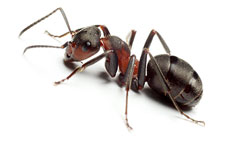 Once you discover your home needs carpenter ant control, the damage has already begun. These pests build nests consisting of a network of tunnels, spreading over time and creating structural damage. How did your home attract carpenter ants in the first place and when should you call a professional ant exterminator?
Once you discover your home needs carpenter ant control, the damage has already begun. These pests build nests consisting of a network of tunnels, spreading over time and creating structural damage. How did your home attract carpenter ants in the first place and when should you call a professional ant exterminator?
1. Carpenter Ants or Termites?
Carpenter ants play a key role in the ecosystem. Their colonies chew up a bunch of wood, which turns into sawdust, rots and turns into compost that spurs new growth. Because of this attribute, carpenter ants may seem very similar to termites. However, wood offers no nutritional value to carpenter ants. Instead of feeding on the cellulose, they simply make tunnels through decaying wood to create a nest. As such, it takes termites far less time to cause significant structural damage.
While carpenter ants are the largest of all common ant species, their winged bodies resemble termites at a glance. Looking closer, these pests have segmented bodies from one-quarter to three-eighths of an inch long. On the other hand, termites don’t have a segmented body and have equal-sized wings that may eventually be shed.
2. Moisture
A problem generally on the East Coast, carpenter ants target damp wood and look for structures with moisture. Within your home, these places tend to be:
- Near points of entry, such as an attic vent, your foundation, cracks, electric wires, pipes and telephone lines.
- Near appliances or in areas where water is used. You’re more likely to find carpenter ants building a nest near a dishwasher or washing machine, by a sink or in your kitchen or bathroom.
Seeing a carpenter ant inside your home doesn’t mean you have an ant infestation. It’s somewhat common for these pests to build nests outdoors and look for food or moisture inside your home. Unlike other ant species, they’ll travel a greater distance for these two sources.
If you suspect a carpenter ant infestation, address the moisture issue first to prevent the colony from spreading. If this doesn’t work, it may be time for professional carpenter ant removal.
3. Inside and Around Wood
Although carpenter ants are more likely to target damp wood, they’ll go after other sources for their nests. In your home, this includes foam or wood insulation and spaces or hollow areas inside doors and window frames.
Once carpenter ants are inside any of these locations, you’ll notice:
- Piles of wood shavings building up below the wooden structure.
- A faint rustling noise, created when the ants burrow into the wood.
- Winged ants coming out of cracks or crevices around the ceiling and walls.
Once you spot these signs, don’t wait to contact the professionals for carpenter ant treatment. Reach out to Eliminate ‘Em’ Pest Control Services for carpenter ant extermination. To make an appointment, give us a call at 1-866-802-7378.


